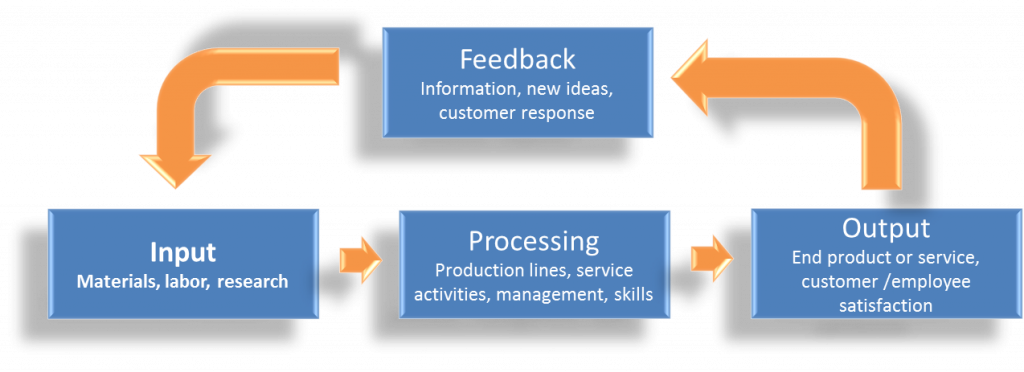8 Systems Thinking
Chapter Table of Contents

The educational system in the US has these parts:
- Preschool and kindergarten,
- Elementary schools – grades 1-6,
- Middle schools – grades 7-8,
- High schools – grades 9-12, and
- Higher education, including 2-year community colleges, and 4-year colleges and universities.
We call this list of parts a “system” because the parts interact with each other to achieve overall goals, such as an educated population. The parts may interact through cause and effect or through the exchange of information or material. We can think of the input and output of the overall system, and we can also think about the input and output of each part; for example, some of the students who graduate from middle school (an output) go on to high school (an input). We can also think of the parts as being processes in the educational system.
In his book,Total Quality Control[1], Feigenbaum defines a system as:
A group or work pattern of interacting human and machine activities, directed by information, which operate on and/or direct material, information, energy, and/or humans to achieve a common specific purpose or objective.
Clearly this definition relates closely to industrial engineering and explains why some industrial engineering departments are called industrial and systems engineering. UTA’s department is called Industrial, Manufacturing, and Systems Engineering. However, systems engineering is also used sometimes in a more limited meaning, to refer to designing a computer and information system.
When we define a system we implicitly draw a line around some parts to include those parts and to exclude others. For example, the educational system includes the schools, but not the roads students travel on to get to school or the organizations that employ students after they graduate. Generally, looking at a larger system is more accurate but harder. We can understand some aspects of the educational system without considering these other parts, but some aspects require looking at the larger system. We can still examine the educational system if we remember to include in our study its interactions with its environment, such as the transportation system and the employment system.
For the IE, the systems approach is important because it reminds us to consider the environment surrounding the system we are studying and to move the boundaries outward as much as possible so that we consider a problem in its larger context.
System Analysis
Some systems have feedback. Feedback in a system is when outputs are fed back in as inputs for future system action. This is sometimes called a feedback loop. The educational system doesn’t tend to have a lot of feedback and that may hamper improvement of the system. Have you ever been asked by your high school to give feedback on how well your education prepared you for college or for work?

The operation of a system that has evolved without conscious design or a system that has been designed piece by piece almost always can be improved. Analysis means to take a system apart in order to understand how the parts work; systems thinking stresses synthesis, that is, understanding how the parts work together and how the system works as a whole. Understanding how each part of the educational system works is not enough for a good understanding and certainly not enough for making recommendations for improving the educational system; better recommendations would come from understanding how the parts of the system work together also.
A system has the property that a change to one part can have effects, sometimes surprising effects, on other parts. A state might require that students entering state-funded four year universities meet certain standards (for example, knowledge of a foreign language). The effects of such a change might be good for the universities, but the effects on the high schools must also be considered; they might, for example, have to provide more language classes and hire more teachers. Improving one part of system may have good or bad consequences on another part of the system. Using antibiotics to cure diseases has had the consequence of creating bacteria that are immune to some antibiotics; within the system of individual patient and doctor, having the patient take antibiotics makes sense, but in the larger system, we might want to be more cautious about their use.
A system may have emergent properties, that is, properties of the whole that are not the property of any part. For example, living systems are alive, but one can’t isolate that property in any part of the system; it is a property of the entire system.
A system can further be classified in these ways:
- Natural (for example, a river) or man-made (for example, a bridge),
- Static (for example, a bridge) or dynamic (for example, the U.S. economy),
- Physical (for example, a factory) or abstract (for example, the architect’s drawing of the factory), and
- Open (interacting with its environment) or closed (interacting very little with its environment)
Certain types of systems with feedback occur frequently in organizations and in society. If you learn to recognize them, you can learn what actions to take. William Braun describes 10 system archetypes:
- Limits to Growth (aka Limits to Success)
- Shifting the Burden
- Eroding Goals
- Escalation
- Success to the Successful
- Tragedy of the Commons
- Fixes that Fail
- Growth and Underinvestment
- Accidental Adversaries
- Attractiveness Principle
This article, Interaction Structures of the Universe, has a summary of the above models.
In this book The Fifth Discipline [2], Peter Senge argues that organizations must become learning organizations by building knowledge of four disciplines: personal mastery, mental models, shared vision, and team learning. The “fifth discipline” is systems thinking, and he gives these laws of complex systems:
- “Today’s problems comes from yesterday’s ‘solutions.'” Solutions can have unintended and undesired effects.
- “The harder you push, the harder the system pushed back.” “Compensating feedback” may keep a system in the state it started.
- “Behavior grows better before it grows worse.” Actions that make short term improvement may cause long term disaster.
- “The easy way out usually leads back in.” Easy and obvious solutions would have been done already if they would have worked. Hard work is needed to find the real solution.
- “The cure can be worse than the disease.” Some easy solutions become addictive.
- “Faster is slower.” Any organization has an optimal rate of growth.
- “Cause and effect are not closely related in time and space.”
- “Small changes can produce big results – but the areas of highest leverage are often the least obvious.”
- “You can have your cake and eat it too – but not at once.” For example, an improvement in quality pays off eventually in improved profits.
- “Dividing an elephant in half does not produce two small elephants.” Some problems must be solved by improving the whole system.
- “There is no blame.” “You and the cause of your problems are part of a single system.”
While most engineers design physical objects (cars, bridges, and so forth), IEs design and improve production systems. A production system is a system that produces goods or services for customers. IEs have to think about how a production system works as a system by using the types of ideas I’ve just described.
Exercise
Choose one of the Laws of Complex Systems which you’ve seen demonstrated in your life. Identify the law you’ve chosen and describe the “real-world” example of it in action which you’ve seen. Your instructor may ask you to submit your answer.

